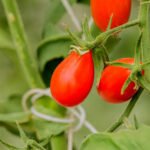Flowers play a crucial role in vegetable gardens, not just for their beauty but also for the numerous benefits they bring. When strategically chosen and planted, flowers can attract beneficial insects and pollinators, enhance soil health, and contribute to the overall aesthetics of the garden. In this article, we will delve into the importance of incorporating flowers into vegetable gardens to create a thriving and harmonious ecosystem.
By including flowers in your vegetable garden, you can attract pollinators such as bees and butterflies, which are essential for fruit set in many crops. Additionally, certain flowers like marigolds act as natural pest deterrents, reducing the need for harmful pesticides. Choosing the right flowers can also improve soil health by providing ground cover, adding organic matter when they decompose, and attracting earthworms that help with soil aeration.
When it comes to selecting flowers for your vegetable garden, options like marigolds, nasturtiums, and calendula stand out as excellent choices due to their beneficial properties. These flowers not only add color and vibrancy but also serve practical purposes such as repelling pests or attracting beneficial insects. By integrating these specific flowers into your garden layout, you can create a more resilient ecosystem that supports both plants and wildlife alike.
Benefits of Flowers in Vegetable Gardens
Flowers are not only beautiful additions to a vegetable garden but also serve multiple purposes that can contribute to the overall health and success of the garden. One key benefit of incorporating flowers into vegetable gardens is their ability to attract beneficial insects and pollinators. Bees, butterflies, and other pollinators are crucial for the fertilization of many vegetable crops, leading to better yields. Flowers like lavender, sunflowers, and bee balm are known for their attractiveness to these helpful bugs.
In addition to attracting pollinators, flowers can also improve soil health in vegetable gardens. Certain flowers have deep roots that help break up compacted soil, allowing for better water infiltration and root growth for vegetables. Marigolds, for example, release chemicals into the soil that can help repel harmful nematodes and promote a healthier ecosystem underground. The presence of diverse plant species like flowers also encourages a balanced microorganism population in the soil, contributing to its overall fertility.
Furthermore, incorporating flowers into vegetable gardens enhances the aesthetics of the space. The vibrant colors and varied textures of different flowering plants can create an eye-catching display that makes gardening more enjoyable.
Not only do flowers add visual appeal, but they can also attract other wildlife like birds that may help with pest control in the garden. By carefully selecting a mix of flowers good for vegetable gardens based on color, height, and bloom time, gardeners can create a visually stunning and productive environment.
| Benefits | Details |
|---|---|
| Attracting Beneficial Insects/Pollinators | Flowers such as lavender and sunflowers attract bees and butterflies essential for pollination. |
| Improving Soil Health | Deep-rooted flowers like marigolds break up compacted soil while releasing chemicals that repel harmful nematodes. |
| Enhancing Aesthetics | The vibrant colors and textures of various flowers make the garden visually appealing while attracting birds for pest control. |
Choosing the Right Flowers
Marigolds are popular companion plants for vegetables as they have natural pest-repellent properties. They can deter nematodes, aphids, and other harmful insects that may damage vegetable crops. Nasturtiums are another excellent choice as they attract beneficial insects like ladybugs and bees, which help with pollination and pest control. Additionally, nasturtiums are edible flowers and can be used in salads or as a garnish, providing a dual purpose in the garden.
Calendula, also known as pot marigold, is a versatile flower that not only adds vibrant color to the garden but also acts as a trap crop for pests. It attracts pests away from vegetable plants, serving as a sacrificial plant that can be easily removed or treated.
Calendula also has medicinal properties and can be used in herbal remedies, making it a valuable addition to any vegetable garden. By carefully selecting and incorporating these flowers into your garden layout, you can create a more diverse and resilient ecosystem that benefits both the plants and the overall health of your garden.
| Flower | Benefit |
|---|---|
| Marigolds | Natural pest-repellent properties |
| Nasturtiums | Attracts beneficial insects like ladybugs |
| Calendula | Acts as trap crop for pests and has medicinal properties |
Companion Planting
One of the key benefits of companion planting with flowers in vegetable gardens is pest control. Certain flowers, such as marigolds, nasturtiums, and calendula, are known for their ability to deter harmful pests and attract predatory insects that feed on them.
For example, marigolds emit a scent that repels nematodes in the soil, while nasturtiums can act as a trap crop for aphids and caterpillars. By strategically interplanting these flowers with vegetables, you can create a more balanced ecosystem that minimizes the need for chemical pesticides.
When choosing flowers for companion planting in vegetable gardens, it’s essential to consider factors such as compatibility with specific vegetables, sunlight requirements, and blooming periods. Creating a diverse mix of flowers throughout the garden can help support biodiversity and attract a wider range of beneficial insects. Additionally, rotating flower species each season can help prevent pest buildup and maintain soil health over time.
- Marigolds: These vibrant flowers are well-known for their ability to repel nematodes in the soil and deter pests like whiteflies and tomato hornworms.
- Nasturtiums: With their edible blooms and leaves, nasturtiums not only add color to the garden but also attract aphids away from crops like tomatoes and cucumbers.
- Calendula: Also known as pot marigold, calendula is valued for its medicinal properties and its attractiveness to pollinators like bees and butterflies.
Incorporating these flowers strategically among your vegetable plants can create a mutually beneficial relationship where both species thrive together. By embracing companion planting with flowers in your vegetable garden, you can enhance plant health, increase yield potential, and contribute to a more sustainable gardening practice overall.
Seasonal Flowers
When planning a vegetable garden, incorporating flowers not only adds visual appeal but also brings a plethora of benefits to the overall ecosystem. One key aspect to consider when choosing flowers for your vegetable garden is selecting species that thrive in different seasons. By strategically planting a variety of seasonal flowers, you can ensure that your garden remains vibrant and colorful throughout the year.
To help you plan for a year-round blooming garden, here are some seasonal flowers to consider:
- Spring: Tulips, daffodils, and pansies are excellent choices for adding color to your garden during the spring season. These early bloomers help attract pollinators and beneficial insects as your vegetables start to grow.
- Summer: Sunflowers, zinnias, and cosmos are popular summer flowers that not only brighten up your garden but also provide nectar for bees and butterflies. These vibrant blooms can complement the lush greenery of your vegetable plants during the peak growing season.
- Fall: As summer transitions into fall, consider planting chrysanthemums, asters, and ornamental kale to extend the flowering season in your garden. These hardy flowers add a pop of color as temperatures start to cool down.
By strategically planning and incorporating seasonal flowers into your vegetable garden, you can create a harmonious balance between aesthetics and functionality. Additionally, rotating flower varieties based on the time of year ensures that pollinators have a continuous food source while enhancing the overall ecosystem of your garden. Remember to research specific care requirements for each type of flower to maximize their bloom potential throughout the seasons.
When designing a year-round blooming garden with seasonal flowers alongside vegetables, take into account factors such as sun exposure, soil quality, and water requirements for both plant types. With proper planning and maintenance, you can enjoy a diverse array of flora in your vegetable garden no matter what time of year it is. Experiment with different combinations of flowers and vegetables to create an attractive and sustainable gardening space that benefits both plants and wildlife alike.
Maintenance Tips
Caring for flowers in a vegetable garden is essential to ensure they thrive and continue to provide all the benefits they bring. One crucial aspect of maintenance is watering. It’s important to water your flowers regularly, especially during hot and dry periods. However, be mindful not to overwater as this can lead to root rot and other issues. A good rule of thumb is to check the moisture level of the soil before watering and adjust accordingly.
In addition to watering, pruning is another key task in maintaining flowers in a vegetable garden. Pruning helps promote healthy growth, remove dead or damaged parts, and shape the plants for aesthetic purposes. When pruning, make sure to use clean and sharp tools to prevent any damage to the plants. Different flowers may require specific pruning techniques, so it’s essential to research the needs of each flower variety in your garden.
Deadheading is also an important maintenance practice that involves removing faded or wilted flowers from the plants. Deadheading encourages continuous blooming by redirecting the plant’s energy from seed production back into producing more blooms. This process not only keeps your flower garden looking neat and tidy but also promotes overall plant health and prolongs flowering season. By regularly deadheading your flowers, you can enjoy beautiful blooms throughout the growing season in your vegetable garden.
Pest Control
When it comes to pest control in vegetable gardens, many gardeners turn to harmful pesticides as a quick solution. However, there are natural and eco-friendly alternatives that can effectively keep pests at bay while also adding beauty to your garden. One such method is using flowers that have natural pest-repelling properties. By incorporating these flowers strategically throughout your vegetable garden, you can create a natural barrier that deters unwanted insects without the need for toxic chemicals.
Beneficial Flowers for Pest Control
One of the most well-known flowers good for vegetable gardens in terms of pest control is marigolds. Marigolds emit a scent that repels many common garden pests, including aphids, nematodes, and whiteflies. Planting marigolds around the perimeter of your vegetable garden or interspersing them among your crops can help protect your plants from damage.
Another beneficial flower is nasturtiums, which not only serve as a trap crop for aphids but also attract predatory insects like ladybugs and hoverflies that feed on garden pests. Additionally, calendula flowers have been found to deter tomato hornworms and cabbage worms, making them an excellent companion plant for tomatoes and cabbage family crops.
Companion Planting Strategies
Incorporating these pest-repelling flowers into your vegetable garden through companion planting can further enhance their effectiveness. For example, planting marigolds alongside tomatoes can help prevent common tomato pests like nematodes and whiteflies.
Similarly, interplanting nasturtiums with squash or cucumbers can protect these crops from aphids while attracting beneficial insects that prey on them. By strategically planning which flowers to pair with your vegetables based on their pest-repelling properties and compatibility with each other, you can create a holistic pest management system that promotes a healthy and balanced ecosystem in your garden.
Success Stories
In conclusion, incorporating flowers into vegetable gardens can truly make a significant difference in the overall success and beauty of your garden. Not only do flowers attract beneficial insects and pollinators, improve soil health, and provide aesthetic value, but they also play a crucial role in companion planting to enhance plant health and deter pests. By selecting the right flowers such as marigolds, nasturtiums, and calendula, gardeners can create a harmonious ecosystem that benefits both vegetables and blooming plants.
Furthermore, considering seasonal flowers is key to planning a year-round blooming garden that will not only look stunning but also support biodiversity in your backyard. By carefully choosing a variety of flowers that thrive in different seasons, gardeners can ensure continuous blooms and active pollination throughout the year. Additionally, practicing proper maintenance techniques like watering, pruning, and deadheading will help keep the flower beds healthy and vibrant.
Lastly, when it comes to pest control in vegetable gardens, opting for natural methods using flowers instead of harmful pesticides is not only environmentally friendly but also effective. Success stories of successful vegetable gardens that have integrated flowers seamlessly serve as inspiration for gardeners looking to enhance their own plots. With proper planning and care, anyone can create a well-balanced and thriving garden filled with a colorful array of flowers that are indeed good for vegetable gardens.
Frequently Asked Questions
What Flowers Should I Put in My Vegetable Garden?
When choosing flowers to plant in your vegetable garden, it’s important to select ones that can attract beneficial insects or pollinators, such as bees and butterflies. Marigolds are a popular choice as they repel pests like nematodes. Additionally, nasturtiums not only add color but can also deter aphids and squash bugs.
What Flowers Keep Pests Away From Vegetables?
Certain flowers can help keep pests away from your vegetables by acting as natural repellents or traps. For example, companion planting marigolds alongside vegetables can repel nematodes, while planting chrysanthemums can deter spider mites and beetles. Additionally, lavender can discourage mosquitoes and flies.
What Are the Best Pollinator Flowers for Vegetable Gardens?
If you want to attract pollinators to your vegetable garden, consider planting flowers that are rich in nectar and pollen. Some of the best pollinator flowers for vegetable gardens include sunflowers, zinnias, cosmos, bee balm, and salvia. These flowers will not only beautify your garden but also support the health of your vegetable plants through increased pollination activities.

If you’re looking to get into vegetable gardening, or are just looking for some tips on how to make your current garden better, then you’ve come to the right place! My name is Ethel and I have been gardening for years. In this blog, I’m going to share with you some of my best tips on how to create a successful vegetable garden.





